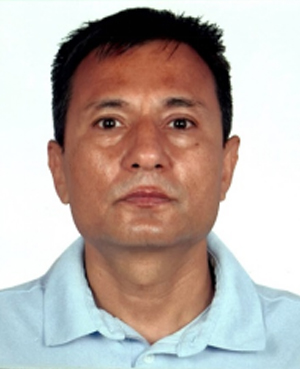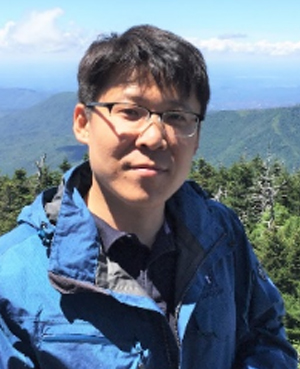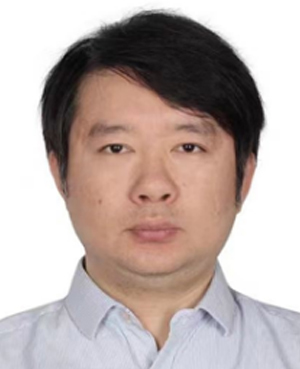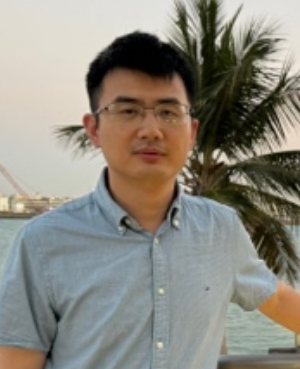
Jianping Guo
Dalian Institute of Chemical Physics, CAS, China
Bio
I am a professor at Dalian Institute of Chemical Physics, CAS. I received my Ph.D. in Physical Chemistry from the University of Chinese Academy of Sciences. My research centers around the exploration of alkali and alkaline earth metal hydrides, imides, and amides for chemical transformations of small molecules such as N2, H2, NH3, and organic molecules.
Title
Nitrogen fixation by hydrides under plasma
Abstract
The development of alternative approaches to the conventional Haber–Bosch ammonia synthesis process is a very challenging task. Extrinsic stimuli such as plasma could provide greater flexibility in materials selection and process innovation for dinitrogen fixation. Hydride (hydrogen anion, H‾)-containing materials have recently shown promise in thermal ammonia synthesis, whereas the interactions of hydrides and N2 under plasma conditions have rarely been investigated. Herein we explore plasma-assisted nitrogen fixation to NH3 mediated by a series of alkali and alkaline earth metal hydrides. The chemical responses of these metal hydrides under nitrogen plasma differ significantly from one another. And the plasma nitrogen fixation behaviors of these hydrides are different from those observed under normal thermal conditions. NaH and KH, which cannot react with N2 under normal thermal conditions, can fix much larger amount of nitrogen under plasma conditions as compared to others. The subsequent thermal-hydrogenation of fixed N produces NH3 facilely. Based on these experimental observations, a plasma-thermal hybrid chemical looping ammonia synthesis process has been proposed. This hybrid ammonia loop effectively prevents NH3 from plasma-induced cracking, a challenging obstacle to overcome in plasma-catalytic ammonia synthesis.

Binod Giri
Brandenburg University of Technology, Germany
Bio
Dr. Binod Giri earned his master’s degree in physical chemistry from Tribhuvan University, Nepal, in 1997. He then served as an assistant professor there before moving to Germany in 2000 as a DAAD scholar. At the University of Karlsruhe (now KIT), he completed his Ph.D. in 2005 under the guidance of Prof. Dr. Horst Hippler, focusing on the reaction kinetics of combustion-related hydrocarbon radicals. After his Ph.D., Dr. Giri joined Argonne National Laboratory, USA, as a postdoctoral researcher with Dr. Robert Tranter, developing methods to study high-temperature combustion chemistry. Between 2007 and 2014, he held various assistant professorships at Canadian universities and was a visiting professor at Acadia University, where he researched atmospheric gas-phase reactions and taught chemistry. At the University of Calgary, he taught chemistry and collaborated on industrial research projects related to the thermophysical properties of sour gases. From 2014 to 2023, he served as a senior research scientist at King Abdullah University of Science and Technology (KAUST) in Saudi Arabia, applying experimental and theoretical methods to combustion research while supervising Ph.D. students. Since 2024, Dr. Giri has been a senior academic staff member at Brandenburg University of Technology, Germany, focusing on the combustion behavior of zero-carbon and carbon-neutral fuels to address global warming.
Title
Ammonia: A Pathway to a Sustainable Energy Future
Abstract
Ammonia has emerged as a key candidate in the global push for decarbonization, with its potential as a carbon-free fuel and hydrogen carrier. Its existing global infrastructure enables rapid deployment and large-scale integration into energy systems. Our research centers on ammonia as a future energy vector, particularly when blended with renewable fuels such as methanol, ethanol, dimethyl ether, and dimethoxymethane. These fuels not only enhance engine performance but also reduce emissions. We have extensively studied ammonia and its blends, generating experimental data under extreme pressure and temperature conditions. By integrating these data with theoretical chemistry and chemical kinetics modeling, we have gained valuable insights into the combustion behavior and fuel kinetics of ammonia-alcohol/ether blends. These insights are critical for optimizing these blends for practical applications in engines like spark ignition, which are vital to achieving a decarbonized energy future. Ammonia-renewable fuel blends present a scalable and sustainable solution, crucial for addressing the ongoing environmental crisis and meeting the increasing energy demands of a growing global population. Our work contributes significantly to developing these NH3-blends as a viable pathway toward a sustainable energy future.

Yoji Kobayashi
KAUST, Saudi Arabia
Bio
Yoji Kobayashi obtained his B.A. (Honors) in organometallic chemistry with David Glueck (Dartmouth College, USA), and in 2002 his PhD in inorganic materials with Thomas Mallouk (Penn State, USA). After postdoctoral work on metal organic frameworks with Jeffrey Long (UC Berkeley), he joined Kyoto University in 2010 as an Assistant Professor, and later Lecturer/Associate Professor. Since 2021, Yoji Kobayashi has been at KAUST, heading his group in solid state chemistry and catalysis.
Title
Dealing with electrons and hydrogen: Novel catalyst materials for ammonia synthesis
Abstract
This talk will present how certain materials separately manipulate electrons and hydrogen in the presence of nitrogen to create ammonia. In the first part, we will explain how group 14 clathrates, typically known for their thermoelectric properties, in fact have low work functions, making them effective Haber-Bosch catalyst supports. In the second part, as time permits, we will show how some hydride-based solids give enhanced reactivity over unusual element sites (Ti, V, Ca, etc.) and overcome the hydrogen poisoning often encountered in Ru-based catalysts.

Felix Leach
University of Oxford, UK
Bio
Felix Leach is an Associate Professor at the University of Oxford. He researches emissions and efficiency in thermal propulsion systems, sustainable fuels such as ammonia and hydrogen, and air quality. Recently, he has been focusing on experiments and modelling of ammonia sprays. He also aims to influence policy towards rapid decarbonization of the transport sector. He has published widely on these topics. Felix is the author of the award-winning SAE book “Racing Toward Zero” about decarbonizing transportation rapidly.
Title
Challenges and opportunities for ammonia as a future energy vector
Abstract
Ammonia has received attention as an alternative hydrogen carrier and a potential fuel for thermal propulsion systems with a lower carbon footprint. However, there are numerous challenges, particularly around safety and ammonia’s energy conversion performance. One strategy for high power density in ammonia applications will be direct injection of liquid ammonia. Understanding the evaporation and mixing processes associated with this is important for model development. This presentation will focus on the challenges and opportunities for ammonia as a future energy vector for propulsion systems, in particular focusing on supporting modelling efforts. Subsequently a look ahead to future directions of research will be explored.

Min Jung Lee
Seoul National University of Science and Technology, South Korea
Bio
Dr. Min Jung Lee is currently an Assistant Professor in the Department of Future Energy Convergence at Seoul National University of Science and Technology, a position held since February 2023. Prior to this, Dr. Lee served as a Principal Researcher at the Korea Institute of Energy Research (KIER) from February 2021 to January 2023, and as a Senior Researcher at KIER from March 2016 to January 2021. He also completed a Postdoctoral Fellowship at the Korea Advanced Institute of Science and Technology (KAIST) from March 2014 to February 2016.
He earned a Ph.D. in Mechanical Engineering, specializing in Combustion Engineering, from Chung-Ang University in February 2014. This was preceded by a master’s degree in mechanical engineering from the same university in February 2010, and a bachelor’s degree in mechanical engineering in February 2008.
Title
A Strategy for Ensuring Flame Stability and Controlling Nitrogen Oxides in Pure Ammonia Combustors
Abstract
This presentation explains the technologies for simultaneously controlling flame stability and nitrogen oxide (NOx) emissions in the combustion of pure ammonia. Ammonia, with its inherently low burning velocity, faces significant challenges in maintaining a stable flame even under premixed combustion conditions. To address these challenges, various approaches such as hydrogen and fossil fuel co-combustion, plasma assistance, and preheating have been extensively studied. However, to fully realize the long-term potential of ammonia as a carbon-free fuel, the development of new combustor designs optimized specifically for pure ammonia is essential. This study focuses on a recently developed high-swirl tangential combustor designed to enhance flame stability in ammonia combustion. Furthermore, it analyzes the effectiveness of a newly proposed staged combustion technique that employs secondary ammonia injection for NOx reduction. Finally, the presentation briefly introduces ongoing ammonia-based research and development projects in South Korea.

Jun Li
Guangzhou Institute of Energy Conversion, CAS, China
Bio
Prof. Jun Li in Guangzhou Institute of Energy Conversion, Chinese Academy of Sciences, was selected into the Talents Program of the Chinese Academy of Sciences, the Chinese Academy of Sciences Youth Team Program, and the Talents Program of Jiangxi Province. Mainly engaged in basic theoretical research and engineering technology development for the combustion and utilization of low-carbon/non-carbon fuels. Focusing on efficient and clean combustion of low-carbon/non-carbon fuels, theoretical and experimental research has been conducted on the combustion characteristics, combustion reaction mechanisms, pollutant generation and control mechanisms of low-carbon/non-carbon fuels. Key technologies and equipment for the utilization of low-carbon/non-carbon fuels have been developed. In the past 3 years, he has presided over and participated in 7 provincial and ministerial projects such as the talent project of the Chinese Academy of Sciences, the key research and development project of Guangdong Province, and the science and technology innovation project of Jiangxi Province.
Title
Ammonia spray combustion: from spray model development to combustion optimization strategy
Abstract
Ammonia is regarded as a promising alternative fuel in internal combustion engine for its potential to reduce carbon emissions, and ammonia spray combustion technology has received intense research interests. However, key impact factors of liquid ammonia spray process and effects of combustion optimization strategy on liquid ammonia-fueled engines are still not well understood.
In this report, we presented a new spray model for liquid ammonia injection, and numerically investigated spray characteristics under diesel-engine conditions. Furthermore, large eddy simulation of ammonia-diesel high pressure injection dual fuel (HPDF) combustion mode has been performed to evaluate the applicability of exhaust gas recirculation strategy in this mode. This report will provide potential support to optimize operation strategy of liquid ammonia-fueled engines.

Wei Li
Shanghai Jiao Tong University, China
Bio
Wei Li is an assistant professor at Shanghai Jiao Tong University, specializing in the combustion kinetics of carbon-neutral fuels. She has published 58 papers in international combustion journals such as Prog. Energy Combust. Sci., Combust. Flame, and Proc. Combust. Inst., with 23 of them as the first/corresponding author. She has led projects funded by the National Natural Science Foundation of China (Youth Project) and the China Postdoctoral Science Foundation (General Project). She has been honored with awards including Bernard Lewis Fellowship of the Combustion Institute, Distinguished Postdoctoral Award of Shanghai Municipality and the Nomination Award of Distinguished PhD Dissertations of Shanghai Jiao Tong University.
Title
Toward Methane-Equivalent Thermochemical Properties In Ammonia Co-Firing Systems For Gas Turbine Applications
Abstract
In future carbon-free energy systems, fuel flexibility stands as a critical requirement for the development of various combustors, encompassing applications such as gas turbines, boilers, furnaces, and stoves. This necessity arises from the diverse and evolving nature of energy sources, especially those low-carbon fuels, thus demanding adaptable combustion technologies. To address the gas turbine application of ammonia (NH3) which belongs to low-combustion reactivity and low-calorific-value fuels, a new strategy is proposed: co-firing NH3 with high reactivity fuels (such as hydrogen) and fuels with high specific properties (such as dimethyl ether and butane) to achieve methane-equivalent thermochemical properties. Tuning fuel thermochemical properties, including calorific value, Wobbe Index, and combustion characteristics, enables their direct use in existing gas fuel combustors without extensive mechanical modifications.

Weixue Li
University of Science and Technology of China, China
Bio
Professor Wei-Xue Li, Chair Professor, University of Science and Technology of China (USTC). He graduated from Wuhan University with a bachelor's degree in theoretical physics in 1992, graduated from the Institute of Mechanics of the Chinese Academy of Sciences with a doctor's degree in 1998, and engaged in postdoctoral research in Fritz Haber Institute in Germany and Aarhus University in Denmark from 1999 to 2004. Prof. Li worked in Dalian Institute of Chemical Physics, Chinese Academy of Sciences from 2004 to 2015 and in University of Science and Technology of China since 2015. Prof. Li’s research interests is theoretical and computational catalysis. He has successively won honorary titles such as the Outstanding Youth of National Natural Science Fundation of China (2012), the China Catalysis Youth Award (2014), the National High-level Innovation Leader (2016), and the Outstanding Research President Award of the USTC (2021). He is the associate editor of ACS Catalysis since December 2021.
Title
Supported Metal Catalysts Boosted by Interpretable Machine Learning
Abstract
Oxide-supported transition metal catalysts are essential for numerous chemical reactions, determining the efficiencies and sustainability of many industrial processes. How metals interact with gaseous reactants and support underneath, i.e., metal-reactant interaction (MRI) and metal-support interaction (MSI), are two cornerstones of supported metal catalysts. MRI determines activity and selectivity, where the nature of the active sites and their structure sensitivity are the keys to rational design of efficient catalysts but have been debated for decades. While MSI is vital in stabilizing dispersed catalysts and impacting a variety of interfacial processes, including charge transfer, chemical composition, perimeter sites, particle morphology, and encapsulation. The significance of MSI makes its modulation one of the few strategies for enhancing catalytic performance, but developing a fundamental theory has been challenging because of the intricate interfaces. To address these challenges, here, we harness the power of interpretable machine learning, domain knowledge, theoretical and experimental data to establish a general theory of MRI and MSI grounded in topological under-coordinated number, metallophilicity and oxophilicity. The theory developed applies to other metal catalysts and metal compound supports.

Dong Liu
Nanjing University of Science and Technology, China
Bio
Dr. Dong Liu completed his Ph.D. degree at Zhejiang University. Dr. Liu is currently a professor and vice dean at School of Energy and Power Engineering in Nanjing University of Science and Technology, and before that he served as a postdoctoral researcher at CNRS-CETHIL in France and Alexander von Humboldt Research Fellow at Bielefeld University with Prof. Dr. Katharina Kohse-Höinghaus in Germany. Also he was a visiting professor at Princeton University with Prof. Yiguang Ju in USA. Prof. Liu’s research interests include low-carbon energy and advanced combustion, combustion diagnostics, soot formation and control, and new combustion technology etc. He has published more than 180 peer-reviewed articles. He has presided several scientific research projects such as the NSFC excellent youth scholars, and was selected as the young and middle-aged academic technology leader of Jiangsu Province, Jiangsu Province Double and Innovation talents etc.
Title
Effects of ammonia addition on soot formation in fuel pyrolysis
Abstract
Carbon-free fuel ammonia contributes to the decarbonization of energy consumption structure. Blending ammonia with conventional carbon-based fuels can often reduce soot emission while improving the combustion performance of ammonia. Effects of adding ammonia are divided into three categories, namely dilution, thermal and chemical effects. Of these, regulation mechanism of chemical effect was the most complex. Chemical effect of added ammonia on soot formation characteristics during hydrocarbons pyrolysis was comprehensively revealed via gas-solid coupling in this work. Nitrogenous species introduced by ammonia addition firstly combined with small hydrocarbons, which led to the decrease of C2 and C4 species, and hindered the conversion of benzene to large PAHs, and available carbon necessary for soot growth was consumed. Besides, increased nitrogen content in soot particles and the presence of nitrogenous functional groups on their surface reliably proved that nitrogen-containing species can preempt the reactive sites on PAHs surface to form saturated nitrogen atoms, which reduced soot reactivity and inhibited soot surface growth, directly reflecting in the decrease of primary soot particles diameter. Future research should focus on the interactions between nitrogen-containing species and hydrocarbons lager than C3 at broad pressures, to accurately understand detailed mechanisms by which adding ammonia regulates soot emission.

Syed Mashruk
Cardiff University, UK
Bio
Syed is currently working as a Lecturer in Thermofluids and Combustion Science at Cardiff University’s School of Engineering. He is also the Zero Carbon Fuels theme leader of the Net Zero Innovation Institute (NZII). He has received his PhD from Cardiff University and his MSc and BEng with 1st class honours from Cranfield University and University of Hertfordshire, respectively. His PhD research was focused on NO formation and measurements using laser diagnostics in various fuel blends. His research is focused on experimental and numerical characterisation of alternative, low carbon fuels for power generation, as well as in aviation and transport industries. He specialises in advanced optical and laser diagnostics systems. He has authored and co-authored various journal/conference publications on the topic of ammonia as an alternative fuel.
Title
Ammonia as a ZC fuel – towards emissions free combustion
Abstract
Ammonia has recently gained interest as a zero-carbon fuel and a potent hydrogen vector. Ammonia suffers from low flame speed and fuel-bound NOx emissions. Recent studies have investigated the applicability of ammonia as a net-zero combustion solution. This lecture will shed light on the recent advancement of ammonia as a fuel using different innovative techniques. The potential of this fuel, along with various shortcomings and challenges will be discussed in different configurations. Particular importance will be given towards NOx formation and mitigation techniques. Research have shown that NO and NO2 emissions peaks around Φ = 0.8 – 0.9 and drops more at the rich side of combustion, whereas N2O becomes a concern below Φ = 0.7. The lecture will further discuss world’s 1st in-situ cracker development and ammonia fed 1MW steam boiler demonstration. Finally, reflections will be made on future works and ammonia’s position in the Net Zero world.

K.D. Kunkuma A. Somarathne
Tohoku University, Japan
Bio
Dr. K.D. Kunkuma A. Somarathne is a Research Fellow at the Institute of Fluid Science (IFS), Tohoku University, Sendai Japan. Dr. Somarathne has been actively involved in cutting-edge research in numerical direct ammonia combustion since joining IFS in 2014, just after completing his PhD at Toyohashi University of Technology, Aichi, Japan. From 2014 through 2019 he engaged in research and development of ammonia gas turbines in collaboration with Tohoku University, Fukushima Renewable Energy Institute (FREA), and IHI Corporation, Japan. His study on numerical analysis of ammonia/air turbulent premixed and non-premixed combustion using LES and swirl flow with rich/lean two-stage combustion is the first numerical proof of concept for low NOx ammonia combustion in a swirl flow combustor with rich/lean two-stage combustion, which led to the development of low NOx technology for world first 50-kW micro gas turbine in FREA. Since 2019 Dr. Somarathne has been engaging in research and development of liquid ammonia direct spray combustion in gas turbines. He mainly focuses on the phenomena of spray formation of liquid ammonia and flash-boiling spray formation due to the thermophysical properties of liquid ammonia. He has been modeling the formation of flash sprays and contributing to the development of techniques for the numerical analysis of liquid ammonia-fired gas turbines. He is the author of many prestigious journal papers on Ammonia combustion with 3000+ Scopus citations.
Title
Towards the development of liquid ammonia-fueled low NOX gas turbine systems (Numerical Study)
Abstract
Recent developments on gaseous ammonia/air combustion indicate that NH3 will be an important energy vector in a carbon-neutral society by 2050. Rich-lean ammonia two-stage combustion was able to reduce NOx emissions in exhaust gas to the order of 100 ppm at 16% O2 concentration and zero unburned NH3 emissions. The world's first 50-kw gaseous ammonia gas turbine system was constructed in Fukushima, Japan. However, ammonia is commercially available as a liquid in high-pressure cylinders at room temperature. Therefore, it has been reported that considerable energy is consumed by the vaporizer and compressor in converting liquid ammonia to gaseous ammonia. On the other hand, high pressure is thermodynamically crucial in improving the efficiency of gas turbine systems. Therefore, ammonia gas turbines at high pressures using liquid ammonia spray combustion contribute to improving the efficiency of the entire gas turbine system, including peripheral equipment. However, when high-pressure liquid ammonia is released through a nozzle below saturation pressure, the liquid is superheated, resulting in severe flash boiling (flash spray) and two-phase mixed flow. Therefore, the numerical analysis of LNH3 flash spray involves the gas phase (continuous phase), the liquid phase (discontinuous phase), and the interaction between the two phases. Furthermore, the resulting two-phase mixed flow has a very low temperature due to the high latent heat of LNH3. Therefore, a preheated air stream is essential for the stable combustion of the LNH3 spray.

Alessandro Stagni
Politecnico di Milano, Italy
Bio
Alessandro Stagni is an Associate Professor at Politecnico di Milano since January 2024. He completed his studies in Chemical Engineering at Politecnico di Milano, also earning a double degree in Chemical and Sustainable Process Engineering at Politecnico di Torino. In 2016, he received his PhD summa cum laude in Industrial Chemistry and Chemical Engineering from Politecnico di Milano. Previously, he served as an Assistant Professor (2017–2024) and postdoctoral researcher (2016–2017) at the same institution, and was a Visiting PhD Student at Stanford University (2015) and a Visiting Researcher at TU Darmstadt (2019). His research activity is focused on the chemical-kinetic analysis of reacting flows, including the development of kinetic mechanisms, by combining first-principles methodologies with data-driven modeling, and subsequent reduction and optimization. His expertise spans the pyrolysis and oxidation of both conventional and next-generation fuels, as well as the formation mechanisms of pollutants like NOx and SOx. Within the current energy transition scenario, his work has increasingly focused on ammonia as a carbon-free energy and hydrogen carrier. He has made significant contributions to understanding the low-temperature oxidation chemistry of ammonia and integrating these findings into a comprehensive kinetic modeling framework with broad applicability.
Title
Pushing the Boundaries of Ammonia Kinetics: Challenges for the Near Future
Abstract
As ammonia emerges as a key player in the energy transition, the efforts to unravel its fundamental behavior have intensified, aiming to enable its widespread use as an energy carrier. Although the past decade has seen impressive advances in theoretical research and kinetic modeling of ammonia pyrolysis and oxidation mechanisms, a comprehensive understanding of its chemistry has not yet been fully achieved. This lecture provides an overview of the state of the art in ammonia kinetics, discussing the theoretical and modeling challenges lying ahead, and highlighting the remaining gaps in the knowledge of its chemistry. In particular, the unsolved issues in the low-temperature chemistry of ammonia and the third-body collision efficiencies in affecting flame propagation and extinction are thoroughly discussed. Finally, the potential of combining ammonia with other carbon-neutral energy carriers is explored in order to optimize the energy portfolio, tailor blends to meet specific user needs, and enhance the fuel flexibility of combustion devices.

Jose Osorio Tejada
University of Warwick, UK
Bio
Dr Jose Osorio Tejada is an assistant professor at the School of Engineering of the University of Warwick (UK). His work focuses on the sustainability analyses of fertilisers and other chemicals produced in plasma reactors supplied by renewable energy. This research is supported by the ERC Synergy Grant “Surface-COnfined fast modulated Plasma for process and Energy intensification” (SCOPE), from the European Commission.
He got his BSc in Industrial Engineering from the Universidad Tecnológica de Pereira (Colombia) in 2009. He worked for four years in the automotive industry before obtaining, in 2012, the Fundación Carolina scholarship to pursue his MSc in Energy Technologies for Sustainable Development at the Universitat Politècnica de València (Spain). He completed his doctoral studies at the Universidad de Zaragoza (Spain) in 2018, where his research focused on the environmental, social, and socioeconomic life cycle assessment of road freight transport and alternative fuels. Then, he worked for two years as a researcher and lecturer at the Faculty of Environmental Sciences of the Universidad Tecnológica de Pereira before joining the University of Warwick.
Title
Environmental Life Cycle Costing Of Conventional And Plasma-based Distributed Ammonia Supply
Abstract
Distributed NH3 production next to farmers can reduce emissions from transport, NH3 storage volume, shortage risks, and price volatility generated by conventional world-scale production. Technologies for small-scale NH3 production, such as plasma reactors, have been recently proposed, but the high production cost in these plants makes plasma technology not attractive. To promote this technology, the environmental benefits should be considered in decision making. In this study, we propose to estimate the environmental impacts using the life cycle assessment methodology and internalize the impacts into the estimated NH3 production cost in Australia. Multi-objective optimization was used to address the economic potential of distributed non-thermal plasma (NTP) plants, benchmarked to a centralized Haber-Bosch plant. The carbon emissions of centralized production were 2.6 tCO2-eq/t NH3, where 16% corresponded to transport. NTP plants reached a rate of -0.84 tCO2-eq/t NH3, using solar energy. NTP plants would produce NH3 at $796 to $2,204 per tonne, which could decrease to $145 per tonne when internalizing the environmental benefits. If the climate change impacts of conventionally made NH3 in Australia are accounted for, it would cost the public administration between $229 million and $5.3 billion annually, which could be used to promote cleaner technologies.

Junjie Wang
Northwestern Polytechnical University, China
Bio
Dr. Junjie Wang is a Professor at Northwestern Polytechnical University, Xi’an, where he holds the deputy director position of the State Key Laboratory of Solidification Processing. Junjie obtained his B.Sc., Master and Ph.D. in Materials Science at Northwestern Polytechnical University. This was followed by a CNRS postdoctoral fellowship at IEMN in France from 2010 to 2012. Then he worked as a postdoc of VITO from 2012-2013 in Belgium. He was awarded the 2013 JSPS research fellowship and spent two years at NIMS as a JSPS research fellow. He held his first faculty position at the Tokyo Institute of Technology, Tokyo, from 2016 to 2018, before returning to China. He has been engaged in material genetic engineering research of electronic materials, catalytic materials and energy materials, and has published more than 80 papers in academic journals such as "Nature Catalysis" and "JACS".
Title
Electron-Deficient Electrides: A Promising Class of Catalyst Materials for Ammonia Energy Application
Abstract
Electrides are distinguished by several key characteristics, including a low work function and strong electron-donating ability. These compounds have demonstrated significant potential in various catalytic reactions, such as ammonia synthesis, ammonia decomposition, and CO2 hydrogenation. Research into electride materials, whether experimental or computational, generally follows an empirical rule: electrides should exist within an electron-rich system where the sum of the standard oxidation states of the anions and cations is positive. Recent studies have identified a new class of electrides with electron-deficient properties, characterized by a negative sum of the standard oxidation states of anions and cations. This discovery was made through a combination of high-throughput calculations, machine learning, and experimental validation. The synthesized electron-deficient electride exhibits a promising balance between chemical stability and catalytic performance for ammonia synthesis, maintaining its effectiveness even after being washed with water for five days. Moreover, further research has demonstrated that this electron-deficient electride excels in ammonia oxidation catalysis in aqueous environments. These preliminary findings suggest that electron-deficient electrides offer new avenues for developing ammonia energy catalysts with both excellent stability and high performance.

Yu Wang
Wuhan University of Technology & Foshan Xianhu Laboratory, China
Bio
Dr. Wang is a professor of mechanical engineering at Wuhan University of Technology, PI of the Combustion & Laser Sensing Laboratory and adunjct professor (www.cls-wut.cn) at Foshan Xianhu Laboratory (http://zccc.xianhulab.com/). He obtained his Master and PhD degree from Tsinghua University (2009) and King Abdullah University of Science and Technology (2013, under the supervision of Prof. Suk Ho Chung), respectively. His main research interests include carbon neutral fuels (Hydrogen/Ammonia/Biofuels), fundamental combustion and fluid dynamics, formation of soot and NOx and optical combustion diagnostics. Dr. Wang has published in the above fields more than 100 peer-reviewed journal papers which received over 4000 citations.
Title
NO/N2O formation characteristics in laminar premixed of ammonia-methane flames
Abstract
Understanding the mechanism of NOx formation and destruction is a prerequisite for the development of effective NOx mitigation techniques in ammonia flames. Nevertheless, quantitative and spatially resolved NO/N2O concentration data in canonical laminar ammonia flames are surprisingly scarce. We developed a NO/N2O measurement method combining microprobe sampling and calibration-free mid-infrared laser absorption spectroscopy and realized spatially-resolved detection with high accuracy and large dynamic ratio. The fidelity of the method has been rigorously tested before being applied to perform a comprehensive parametric study on NO and N2O formation in NH3-CH4 co-fired burner-stabilized premixed flames. The effects of NH3 fuel ratio, equivalence ratio and flame temperature on NO/N2O formation has been experimentally determined. The present study not only provide extensive spatially-resolved NO/N2O data in ammonia flames that is urgently needed for the development and validation of NH3 combustion mechanisms, the comparison between neat CH4 and NH3-cofired also points to a fact that traditional NOx mitigation technique that are popular in combustion of hydrocarbon fuels may not be appropriate in NH3 flames. Perhaps most interestingly, the present experimental results show an oxygen-enriched oxidizer can in some cases reduce NO emission from NH3 flames.

Yuqing Wang
Beijing Institute of Technology, China
Bio
Yuqing Wang received her BEng degree and PhD from Tsinghua University in 2012 and 2017, respectively. She joined Beijing Institute of Technology as assistant professor (2017-2022), associate professor (2022-2023) and professor (since 2023). Prof. Wang received the Humboldt Fellowship in 2017 and conducted collaboration research as a senior scientist at Karlsruhe Institute of Technology, Germany for one and a half years between 2017 and 2020. Her current research interests include solid oxide cells, multiscale modeling of chemical/electrochemical reaction processes, and distributed energy systems. She has published more than 30 research papers in a wide range of high-quality journals, 20 of which have her as the first/corresponding author.
Title
Ammonia-Fueled Solid Oxide Fuel Cells: Mechanism Studies and Stack Integration
Abstract
Ammonia-fueled solid oxide fuel cell (SOFC) is a promising energy conversion technology due to its high efficiency and carbon-free characteristics. In typical nickel-based anodes, the ammonia decomposition and electrochemical oxidation are directly coupled, which determines the performance of ammonia-fueled SOFCs. In this lecture, the mechanism studies and stack integration of ammonia-fueled SOFCs will be introduced. The reaction mechanism is studied by patterned anode experiments and elementary reaction modeling. Multiscale models from the electrode, to the unit and stack are developed for understanding the coupling effect of reaction and transport processes. At last, advanced heat management strategies are proposed and compact stack integration is realized based on ammonia fuel.

Huahua Xiao
University of Science and Technology of China, China
Bio
Dr. Huahua Xiao is currently a Professor in the State Key Laboratory of Fire Science at the University of Science and Technology of China (USTC). He received his PhD from USTC in 2013. Prior to joining USTC in September 2018, he worked as a Research Associate/Research Assistant Professor at the University of Maryland from 2014 to 2018. His research has focused on flame dynamics, deflagration-to-detonation transition, and numerical algorithm and model development of fires and explosions. He was selected for the National Youth Talent Program and evaluated as “Excellence” upon the completion of the program (the rate of Excellence less than 20%). In addition, he was awarded the Youth Science and Technology Award of the China Association for Public Safety, Best PhD Thesis Award and President Award from Chinese Academy of Sciences, etc.
Title
Fundamental mechanism of explosion of ammonia blends
Abstract
Understanding fundamental mechanism of explosions of ammonia blends is important for the safe transportation and use of ammonia. Blending ammonia with high-reactivity fuels, such as hydrogen and dimethyl ether (DME), is a promising way to improve the combustion performance of ammonia. However, this leads to a higher risk of explosions since the reactivity of the mixtures is increases. While combustion and explosions of ammonia, hydrogen or DME have been scrutinized in previous work, fundamental mechanism of explosion of ammonia blended with hydrogen/DME received less attention and deserves further study. In this lecture, I will start by discussing the chemical kinetics mechanism of NH3/DME/H2 mixed combustion. Next, the lecture will show experiments of the dynamics of NH3/DME/Air premixed flames under different initial conditions. The effect of hydrogen addition on the propagation of NH3/Air and NH3/DME/Air premixed flames will be also talked. Then, I will present experimental and theoretical investigation of the explosion characteristics of NH3/DME/H2/Air premixtures. Results, that address the prediction of explosion overpressures of various low-carbon fuels such as H2, DME, and NH3/DME, will be presented.

Tian-Nan Ye
Shanghai Jiao Tong University, China
Bio
Dr. Tian-Nan Ye received his PhD degree from Shanghai Jiao Tong University. After that, he joined the Materials Research Center for Element Strategy and worked as a specially appointed assistant professor at Tokyo Institute of Technology. During this period, he also received JSPS postdoctoral fellowship and became a JSPS research fellow. He is currently an associate professor at the Frontiers Science Center for Transformative Molecules of Shanghai Jiao Tong University. He has received several awards including ACS Catalysis Award for Early Career Researcher (2018), Excellent Overseas Young Investigator Award from National Natural Science Foundation of China (2021). His research interests involve the development of inorganic functional materials and their applications in the catalysis and energy fields.
Title
Vacancies boost nitrogen activation for ammonia synthesis
Abstract
Ammonia synthesis is one of the most important catalytic processes in the chemical industry. While Fe and Ru are efficient for N≡N bond cleavage, low cost and earth abundant elements such as Ni and Co exhibit much poorer activity due to their weak nitrogen adsorption energy. Here, we report that Ni, Co-loaded rare-earth nitride works as stable and highly efficient catalyst for ammonia synthesis along with a new mechanism. A high density of nitride vacancies is formed with low formation energy, which enables N2 activation at the vacancy sites. Consequently, the reaction rate and turnover frequency (TOF) of the nitride catalysts are quite high at 400 °C and under ambient pressure, and even comparable to those of Ru-based catalysts. Kinetic analysis and isotope experiments combined with density functional theory (DFT) calculations indicate that the nitrogen vacancies generated play a dominant role in the reaction mechanism, and contribute to both the adsorption and activation of N2 molecules. These results indicate the potential role of vacancy sites in the reaction cycles, and provide a new catalyst design concept for earth-abundant catalysts in ammonia synthesis.

Ke Zhang
Technical University of Denmark, Denmark
Bio
Dr. Ke Zhang earned his Ph.D. in September 2017 from the Fritz Haber Institute of the Max Planck Society, Germany, under Prof. Hajo Freund. His doctoral research focused on utilizing surface science techniques to investigate strong metal-support interactions in model catalyst systems and their impact on CO oxidation. During his postdoctoral tenure, Dr. Zhang made significant contributions to advancing the mass-selected cluster source technique and its applications in model catalyst studies, particularly on N2 activation and ammonia synthesis. He led the design, construction, and modification of mass-selected cluster beam systems based on various technical approaches, as well as the development of UHV compatible, high-sensitivity atmospheric pressure reactors. His work involved close collaboration with research groups at the École Polytechnique Fédérale de Lausanne (with Prof. Harald Brune), the Technical University of Munich (with Prof. Ueli Heiz), and the Technical University of Denmark (with Prof. Ib Chorkendorff).
In June 2024, Dr. Zhang was promoted as Senior Researcher at the Technical University of Denmark. As of August 2024, he was appointed Assistant Professor at ShanghaiTech University. Dr. Ke Zhang has published 11 peer-reviewed papers in journals such as Science, Nature Energy, Angewandte Chemie, Journal of Catalysis etc. as the first and corresponding author.
Title
Model catalyst insights towards a new promotion mechanism for ammonia synthesis under mild conditions
Abstract
Over the past two decades, there has been growing interest in developing catalysts to enable Haber-Bosch ammonia synthesis under milder conditions than currently pertain. Rational catalyst design requires theoretical guidance and clear mechanistic understanding. Recently, a spin-mediated promotion mechanism was proposed to activate traditionally unreactive magnetic materials such as cobalt (Co) for ammonia synthesis by introducing hetero metal atoms bound to the active site of the catalyst surface. We combined theory and experiment to validate this promotion mechanism on the La/Co and NbN/Co system. By conducting elaborate model catalyst studies on Co single crystals and mass-selected Co nanoparticles at ambient pressure, we identified the active site for ammonia synthesis over Co based catalysts, as well as the spin mediated promotion mechanism with promotors of different chemical states.



 loading......
loading......